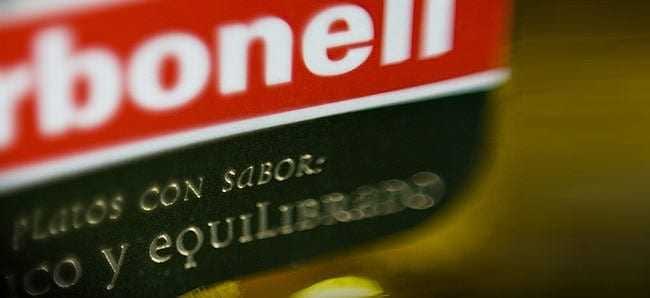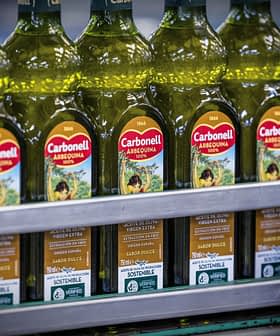
After several years of self-admitted semi-silence, Deoleo, the world’s biggest olive oil bottler, has spoken about its “radical transformation” and imminent launch of products marking a new paradigm of innovation.
A stronger pitch for the health segment is promised and could see the new items in the Carbonell portfolio — going on sale in January — feature an olive oil mixed with an omega 3 oil and a special oil blend for children.
The Madrid-based giant has undergone major changes including a big downsizing of staff and factories, a move to just-in-time inventories — not without trauma for producers — and a brutal price battle with the thriving store brands.
The new Deoleo: not an olive oil company, a consumer goods one
The leaner, more efficient and less debt-saddled Deoleo is moving from an era of restructuring to one of innovation, chief executive Jaime Carbó said at the presentation of the company’s third quarter results and overview of its strategic plan at the Madrid stock exchange on November 8.
Carbó stressed that Deoleo wasn’t “an agribusiness but a fast moving consumer goods company.”
One of the important messages, he said, is that “we’re not just going to dedicate ourselves to selling olive oil in the traditional way but in the modern way.”
It was a message also shared by Gregorio Jiménez López, who joined Deoleo last year to advise on strategy and innovation. Jiménez said the company was seeking to differentiate itself and on a path involving radical change to the traditional concept held of it.
“Deoleo isn’t an olive oil producer, it sells good products for consumers. It packages edible oils,” he said.
Talk of “more healthful” products using “cheaper oils”
“Lipids are going to become the main generators of health in the 21st century and therein lies an extraordinary opportunity,” Jiménez said.
One of the company’s new platforms is therefore based on how to improve the functionality of olive oil and another on doing the same for its seed oils business.
“Olive oil, as a monounsaturated fat, is perfectly healthy as a replacement for butter or saturated fats but it lacks functionalities, therefore we need to complement it with essential fatty acids, and above all with highly unsaturated fats, polyunsaturated fats, of the omega 3 DHA type, he said.”
“What matters is the science and the science says that a range of fatty acids should be consumed, in addition to those in olive oil.”
“Fortunately we can incorporate a mix of different oils, that are cheaper than olive oil, because olive oil has a very high price.” Deoleo could therefore not only gain value via the health segment, but “with products that are cheaper because they use cheaper raw materials,” he said, “offering oils of much more nutritional and health value and at a lower price.”
Segmentation seen as key to future success
Drawing on his 20 years heading the dairy company Puleva — during which he led its development of fortified milk products — Jiménez said that when the company had just sold milk, it didn’t make money, but when it sold products such as an omega 3‑enriched milk and a milk for children, it did.
He did not give any details of the new products planned but a search of Spain’s trade mark register shows that earlier this month Deoleo applied to register the Spanish equivalent of “Carbonell 0.4 helps care for your heart” and in June “Carbonell Kids” and “Carbonell Kidds”.
Carbonell’s Dutch website refers to Carbonell olive oil enriched with Omega 3 (EPA / DHA) and says it is “good for your heart and cholesterol levels.”
Carbonell and Deoleo stablemate Bertolli are the world’s top two olive oil brands in terms of the value of their market share.
The success of Deoleo’s spray formats
Responding to a question from a bank analyst on what kinds of returns Deoleo could achieve on its new products, Carbó gave the example of the Carbonell spray format launched last year, which has a volume of about 200ml and is sold “at the price of a liter.”
It doesn’t work out to a return five times that of standard one liter bottle, because production costs are higher, but nevertheless, “the margin in Spain — one of the toughest markets there is — is 3 – 4 times higher,” he said
When consumers see one liter bottles of brands A, B, C and Carbonell on a supermarket shelf, the comparison is linear — one liter is seen as the same as another liter of oil, he said.
But this changes when consumers lose a price reference. “When you change the parameter, then they can’t compare,” Carbó said.
Cutting out the middlemen, buying local in key markets
Another key change is Deoleo’s new policy of “buying local in key markets”, a strategy designed to increase its earnings “by absorbing the intermediaries’ margins,” Deoleo said in a document in Spanish on its strategic revision.
Deoleo’s general manager of purchases, logistics and quality, Carlos Jiménez Ot, explained at the presentation that five years ago Deoleo bought 60 percent of its supplies from producers and the rest through intermediaries. “Now Deoleo buys 98 percent of its supplies direct from producers.”
“Five years ago we bought four percent of our supplies outside the EU, now it’s 14 percent.”
“We have the freedom today to buy 40 million liters from the supplier Pepe Lopez in…Murcia , and I could buy 50 million liters from Boundary Bend in Australia.
“What do I base it on? On sensory profiles, what my client wants, on legal factors, and the destination. Who the product is for, what product they want, and where works out the most efficient for me to buy.
“Today I’m 100 percent free to buy oil in any part of the world and tomorrow I want to be free to package oil in any part of the world,” he added.
Carbó shared later that in the last year, Deoleo had bought Australian olive oil, packaged it in Europe, and later sold it to America. “It sounds strange but the numbers added up,” he said.
Coming next: the price battle with store brands, Deoleo’s most lucrative markets, how olive oil producers have — reluctantly — helped improve its working capital position, and the state of Deoleo’s financial health.



